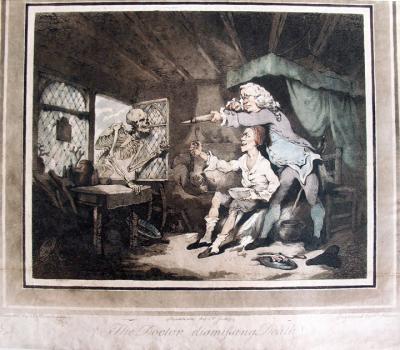The Doctor Dismissing Death, 1785. Designed by Thomas Rowlandson (1756-1827), engraved by P. Simon, aquatinted by Francis Jukes (1747-1812). GC112 Thomas Rowlandson Collection. Gift of Dickson Q. Brown, Class of 1895.
In this print, not included in the British Museum’s collection, a skeleton representing death is entering through a cottage window and being driven back by the doctor’s syringe (an enima?). The print’s young designer, Thomas Rowlandson, had only recently begun painting with watercolor. He was assisted in the printing of the delicate design by Francis Jukes, who specialized in aquatint, a new intaglio process used to add tone and color to an image.
The first French prints with aquatint ground were probably those made around 1761 by François-Philippe Charpentier (1734-1817) and his Swedish pupil Per Gustaf Floding (1731-1791). Another method of aquatinting was invented independently by Jean-Baptiste Le Prince (1734-1781) in 1769. A few years later, Peter Perez Burdett (died 1793) brought the process to England, where Jukes was another early master of the technique. Thomas Gainsborough, Paul Sandby, and Goya were among the many others who used the aquatint process to enhance their fine art prints.
For a complete history, see MoMA’s excellent descriptions of printing processes: http://www.moma.org/collection/details.php?themeid=10452§ionid=T003497
